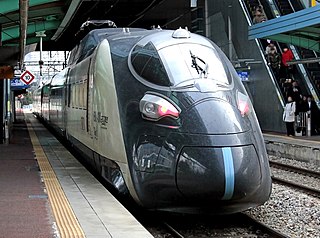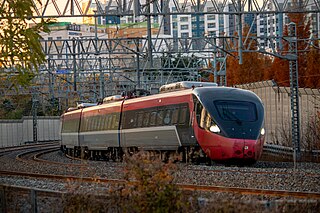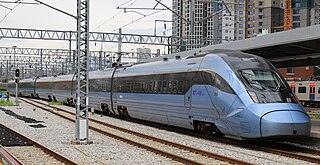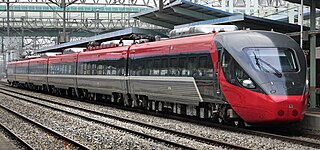
The Gyeongbu line (Gyeongbuseon) is a railway line in South Korea and is considered to be the most important and one of the oldest in the country. It was constructed in 1905, connecting Seoul with Busan via Suwon, Daejeon, and Daegu. It is by far the most heavily travelled rail line in South Korea.

Korea Train eXpress (Korean: 한국고속철도), often known as KTX, is South Korea's high-speed rail system, operated by Korail. Construction began on the high-speed line from Seoul to Busan in 1992. KTX services were launched on April 1, 2004.

Hyundai Rotem Co. is a South Korean company that manufactures rolling stock, defense products and plant equipment. It is a part of the Hyundai Motor Group. Its name was changed from Rotem to Hyundai Rotem in December 2007 to reflect the parent company. It is also called Hyundai Railroad Technology Systems.

The K1, also known as Type 88 by American engineers, is a South Korean main battle tank designed by Chrysler Defense and Hyundai Precision Industry for the Republic of Korea Armed Forces. The vehicle's design was based on technology from Chrysler's M1 Abrams, tailored to meet the ROK's unique requirements. The K1A1 is an up-gunned variant with a 120 mm 44 caliber smoothbore gun, and outfitted with more modern electronics, ballistic computers, fire control systems, and armor. Hyundai Rotem produced 1,511 K1 and K1A1 tanks between 1986 and 2011.

K2 Black Panther is a South Korean fourth-generation main battle tank (MBT), designed by the Agency for Defense Development and manufactured by Hyundai Rotem. The tank's design began in the 1990s to meet the strategic requirements of the Republic of Korea Army's reform for three-dimensional, high-speed maneuver warfare based on use of network-centric warfare.

Railways are a part of the transport network in South Korea and an important mode of the conveyance of people and goods, though they play a secondary role compared to the road network. The network consists of 4,285 km (2,663 mi) of standard-gauge lines connecting all major cities with the exception of Jeju City on Jeju Island, which does not have railways; of the network, 2,790 km (1,730 mi) are double-tracked and 3,187 km (1,980 mi) are electrified. In 2018, rails carried 11.5 percent of all traffic in South Korea – 134.8 million passengers and 30.9 million tonnes of freight – with roads carrying 88.3 percent.

HSR-350x, alternatively called G7, KHST or NG-KTX, is a South Korean experimental high-speed train. It was developed and built in a joint project of government research institutes, universities and private companies that started in 1996, which aimed to reduce import dependence in high-speed rail technology. New components developed for the HSR-350x included motors, electronics, and the carbody of passenger cars. Test runs were conducted between 2002 and 2008. The experimental train achieved the South Korean rail speed record of 352.4 km/h (219.0 mph) in 2004. The HSR-350x was the basis for Korail's KTX-II (KTX-Sancheon) commercial high-speed trains.

Tilting Train Express (TTX) or Hanvit 200 is a South Korean experimental tilting train, which was tested by the Korea Railroad Research Institute (KRRI).

The Gyeongbu high-speed railway, also known as Gyeongbu HSR, is South Korea's first high-speed rail line from Seoul to Busan. KTX high-speed trains operate three sections of the line: on 1 April 2004, the first between a junction near Geumcheon-gu Office station, Seoul and a junction at Daejeonjochajang station north of Daejeon, and a second between a junction at Okcheon station, southeast of Daejeon, and a junction near Jicheon station, north of Daegu entered service; then on 1 November 2010, the third section, between a junction west of Daegu and Busan became operational. The missing gaps across the urban areas of Daejeon and Daegu were in construction for an expected opening in 2014, separate tracks into Seoul Station were also planned. The temporary ends of the three sections were connected to the parallel conventional Gyeongbu Line by tracks that will serve as interconnector branches upon the completion of the entire line. On 1 August 2015, construction on urban areas of Daejeon and Daegu were completed; all the sections of HSR line were connected.

The Honam high-speed railway, also known as Honam HSR, is a high-speed rail between Osong and Mokpo in South Korea. The line is a part of Korail's Korea Train Express (KTX) system, accelerating Seoul–Mokpo and Seoul–Gwangju KTX high-speed services which currently use the existing conventional Honam Line. On April 1, 2015, the line was inaugurated by the South Korean President Park Geun-hye with the attendance of 1200 invited guests and members of the public at Gwangju Songjeong Station in Gwangju, the line's terminus. The line diverges from Osong station on the Gyeongbu high-speed railway, and stops at Gongju, Iksan, Jeongeup Stations. Journey times between Seoul and Gwangju has been cut from 2 h 40 min to just 90 min, making daily commuting possible. The Honam HSR is intended to bring business, and economic opportunities to the province of Jeollanam-do, which has seen slower development than other parts of South Korea. The line has been open to the public since April 2, 2015 for revenue service.

Ilsan Line is a subway line operated by Korail, in Seoul, South Korea. Trains from this line continue to and from Seoul Metro's Line 3.

The KTX-Sancheon is a South Korean high-speed train built by Hyundai Rotem in the second half of the 2000s and operated by Korail since March 2010. With a top speed of 305 km/h (189.5 mph), the KTX-Sancheon is the second commercial high-speed train operated in South Korea and the first domestic high-speed train that is designed and developed in South Korea.

The KTX-I, also known as the TGV-K or Korail Class 100000, is a South Korean high speed train class based on the French TGV Réseau. The 20-car formation of the trainsets without a restaurant car is optimized for high capacity. The 46 trainsets were built partly in France and partly in South Korea in the framework of a technology transfer agreement, which was the basis for further domestic high-speed train development in South Korea.

HEMU-430X is a South Korean high-speed train intended for a maximum speed of 430 km/h (267 mph). On 31 March 2013, it achieved 421.4 km/h (261.8 mph) in a test run, making South Korea the world's fourth country after France, Japan and China to develop a high-speed train running above 420 km/h (261 mph). The main new feature of the train compared to older South Korean high-speed trains is distributed traction. The commercial versions of the trains, tentatively named the EMU-260 and EMU-320, were delivered to Korail from 2020 to 2021.
High-speed rail service in South Korea began with the construction of a high-speed line from Seoul to Busan in 1992, and was inspired by Japan's Shinkansen. The first commercial high-speed rail service was launched on 1 April 2004. Currently, South Korea hosts two high-speed rail operators: Korea Train eXpress (KTX) and Super Rapid Train (SRT).

The Intercity Train eXpress-Saemaeul is a class of train operated by Korail, the national railroad of South Korea, it was introduced on May 12, 2014, to replace the Saemaeul-ho. The new ITX-Saemaeul trains have a faster average speed of 150 kilometers per hour. The name was taken from the Saemaul Undong after a public competition to determine the new train's name.

The LRTA 2000 class is a class of electric multiple units in operation on the LRT Line 2, manufactured by Rotem and Toshiba.

The KTX-Eum or Korail Class 150000 is a South Korean high-speed electric multiple unit train manufactured by Hyundai Rotem and operated by Korail. The word 'eum' in Korean means 'uniting through connection'. This name was selected by members of the public, and expresses the desire to connect regions, people, and happiness through trains.

The KTX-Cheongryong or Korail Class 160000 is a South Korean high-speed electrical multiple unit train manufactured by Hyundai Rotem and operated by Korail.

The Korail Class 210000, also known as the EMU-150, is a South Korean higher-speed electrical multiple unit train manufactured by Hyundai Rotem and Woojin Industrial System Company Limited and operated by Korail on ITX-Saemaeul services since 2014.
















